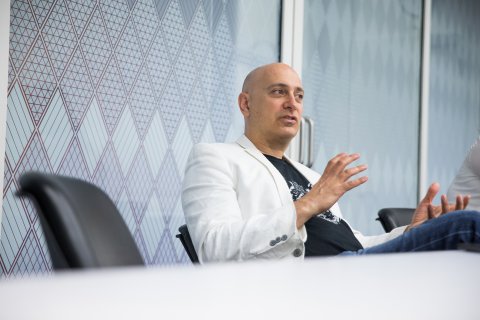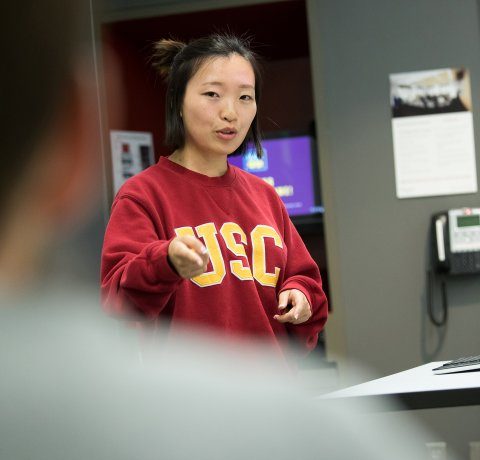Hufschmid Chair pioneered the method of research, a subset of digital anthropology
It isn't often students get a front-row seat to an academic first. But this past spring, 11 USC Annenberg master’s students participated in the world premiere of “Netnography,” the course. Although netnography is widely used in classroom exercises, this was the first time anyone taught a course exclusively devoted to the powerful social media research method.

Robert Kozinets is netnography’s inventor. In the 1990s, he coined the term — fusing Internet with ethnography — and developed the research method from the ground up. He literally wrote the book on the methodology, currently being revised for its third-edition release.
A subset of digital anthropology, netnography is a systematic, ethical approach to following the millions of bread crumbs scattered in plain view across social media platforms. Though few laymen have heard of it, netnography has been in wide use in the professional worlds of marketing research and strategic public relations for more than a decade. It's how Nivea identified the next big thing in deodorants — a product that leaves no chalky trace on your shirt. When L’Oréal wanted to know why Chinese Canadian consumers were “over-indexing” — buying and spending a lot more than the average Canadian — they hired Kozinets to investigate. His ethnographic interviews with Toronto- and Vancouver-area women probed the beauty principles and social codes that explain the pattern.
Learning from the Master
When Kozinets, who is Hufschmid Chair of Strategic Public Relations and Business Communications, joined USC’s faculty in 2016, he couldn’t wait to teach a course in netnography. “This is something I’ve wanted to do for at least a decade,” he said. “I have been busy developing other classes in entertainment marketing, social media marketing and retail analytics at other schools. Finally, here at USC, I had the opportunity to launch this one on netnography, which is my baby.”
On the final day of the inaugural class, Amy Li MA ’17 presented her netnography on American users of Huawei mobile phones. Li had wanted to know how the Chinese telecom giant could better leverage social media to break into the U.S. market. Huawei is ubiquitous in China, and Europe, known for its distinctive “wolf” culture, budget pricing and outstanding quality. Yet most Americans have never heard of Huawei and struggle to pronounce its name. Could social media help? Fifteen weeks of online scouting, data collection, coding and analysis and in-depth interviews had revealed two important subcultures — Li called them die-hards and switchers. The former are passionate about their Huawei phones, but mostly quiet on social media; the latter are loud but fickle. If Huawei could mobilize these two audiences as brand ambassadors, the impact might be big.
Huawei was a natural focus for Li; at the start of the class, she landed a job with the international marketing department of the company’s Shenzhen headquarters. She’ll now be putting her netnography insights to use.

Marcee Davis MA ’17 investigated online conversations among women veterans, revealing a common frustration over feeling forgotten and invisible. From these social media insights, Davis — herself a veteran — proposed ways the Department of Veterans Affairs could improve messaging to its growing population of young, female clients. A good start, she suggested, would be to stop addressing them as “mister.” Davis is currently turning that netnography project into her master’s thesis — and working with Kozinets.
Another netnography project on Hulu users, developed by Amy Chiu MA ’17, uncovered an intriguing subculture of people using the streaming service as a “synthetic companion”— to provide background noise while they work or sleep, or a familiar voice while they do mindless chores. They “listen to” rather than “watch” Hulu, repeating episodes they’ve already seen.
“It turned out that Instagram and YouTube were really important for Amy’s project,” Kozinets noted. “People weren’t going on forums and saying: ‘I listen to Hulu in the background.’” Rather, they posted pictures or video with Hulu visible on a screen in the background. With netnography, he explained, “very often you’re looking for a needle in haystack. Something unusual that might give you an idea of where the mainstream is headed.”
The Never-Ending Convention
Kozinets developed netnography in 1995 as a doctoral student in marketing at Queen’s University in Canada. He was studying how Star Trek fans relate to merchandising. When he asked a group of convention-goers to recommend future Trekkie meetups, they named a few. But the best convention, they told Kozinets, was happening 24/7 — online.
A light bulb metaphorically switched on over his head.
Kozinets signed up for a Prodigy account and started hanging out on Star Trek UseNet newsgroups. He went on to pioneer the way scholars approach this treasure trove of mostly anonymous data, and netnography was born.
“I never thought I was doing anything that important at the time,” he said. “I just took what was going on in anthropology and adapted it to how things were unfolding in the world of networked communications between people.”
Kozinets' seminal work has spawned thousands of scholarly papers and hundreds of market research studies. His own publications include more than 100 journal articles, chapters, case studies and videographies, as well as a textbook and four monographs. He has constructed ethnographies of Burning Man participants, coffee connoisseurs and American Girl brand shoppers. His netnographies commissioned by corporate clients have explored recipe sharing behaviors for Campbell’s Soup, credit card innovators for American Express, medical influencers for Merck, and business insurance trends for Zurich Insurance, as well as many other projects.
Only at USC
USC Annenberg’s inaugural netnography class attracted students from across its PR, global communication and communication management master’s programs.
“I really wanted something new,” said Alex Forbess MA ’17, a global communication student. Netnography “seemed foreign at first,” but a series of one-on-one conversations with Kozinets outside class brought reassuring clarity. “I couldn’t believe how helpful he was,” Forbess added.
This isn’t the first time Kozinets has taught netnography. As a visiting professor, he has presented weeklong modules to PhD students in Brazil, the United Kingdom, Norway, Australia and New Zealand. But USC Annenberg’s PR 599: “Netnography for Digital Communications Insights” was the first semester-long course for graduate credit. A second course was offered simultaneously through USC’s Marshall School of Business, where Kozinets holds a joint appointment. That class drew 41 students, mostly marketing majors.
The two USC netnography courses are similar, but while USC Marshall students worked in project teams, the smaller Annenberg course forced students to work solo.

Hurley’s netnography looked at social media audience engagement opportunities for REI. The outdoor gear retailer had moved the engagement needle with its #optoutside anti-Black Friday campaign and its Force of Nature women’s empowerment campaign. But more seemed possible. Hurley broke down the social media communities around backpacking, hiking and running into eight experience levels — Alpinists at the top, novices at the bottom. Within the novice group, he identified four distinct subgroups: athletic, aspirational, adventurous and first-timers.
More valuable than the specifics of his REI netnography, however, is the appreciation Hurley gained for real-world qualitative research.
“That’s what the class left all of us with: that this is difficult to do. It takes time. And it’s important,” he said.
In His Own Words
Robert Kozinets:
“The way businesses do research is being transformed by the availability of so much data. However, students barely get a taste of these changes. When they do, it tends to be the big-data view. It’s very quantitative, very distant from people’s actual social experiences. That might fly in a typical b-school, but it won’t do for a cutting-edge communication school like USC Annenberg.
The premise of an anthropological approach to data is to focus in on the interaction and experience, and to include the researcher’s own participation. Whether people are sharing Snaps, Tweets, videos, emojis or Instagram posts, these are human beings having different kinds of conversations, creating deeply meaningful micro-broadcasts and mini-cultures using communication technology. What they’re creating is important and special to them. It is created for them, not for us. So, as a researcher, I feel an obligation to treat that data and the ordinary people creating it as special, too. We treat it ethically and with a large degree of respect. And, like good anthropologists, we participate.
Ethnographers in marketing and PR follow people around. They go into their homes, with permission, and they watch them cook, they eat with them, or they watch TV with them. They sit in on family discussions. That’s a wonderful way to gain insight into people’s daily beliefs and routines, but it’s time-consuming and expensive. Now, people share everything online. So we can gain a lot of the exact same insights from the constant stream of incredibly rich social media data. But that means handling that data very differently from the way big data tends to get treated.
I’m not against big-data types of statistical analysis at all. It gives us an amazing overview of what many people are saying, what the average user is doing and what the big trends are. Big data and quantitative methods like surveys are incredibly helpful in describing what is happening across whole domains, like the online world.
Netnography, however, looks at individuals. It seeks out the outliers who have original ideas. It tries to understand the meaning and the values behind what people are sharing, doing, and talking about online. It not only tells us what is happening, but explains why it is happening. If you are a public relations, marketing or communication management practitioner trying to operate in today’s enormously complex world, it’s a very powerful thing to be able to say ‘this is what is happening’, and then to be able to follow up with ‘and this is why it is happening.’
It’s been 20 years in the making, but that’s the kind of unique understanding this new course in netnography offers to USC Annenberg students.”

